Kuk-Jin Yoon
Robust Adverse Weather Removal via Spectral-based Spatial Grouping
Jul 30, 2025Abstract:Adverse weather conditions cause diverse and complex degradation patterns, driving the development of All-in-One (AiO) models. However, recent AiO solutions still struggle to capture diverse degradations, since global filtering methods like direct operations on the frequency domain fail to handle highly variable and localized distortions. To address these issue, we propose Spectral-based Spatial Grouping Transformer (SSGformer), a novel approach that leverages spectral decomposition and group-wise attention for multi-weather image restoration. SSGformer decomposes images into high-frequency edge features using conventional edge detection and low-frequency information via Singular Value Decomposition. We utilize multi-head linear attention to effectively model the relationship between these features. The fused features are integrated with the input to generate a grouping-mask that clusters regions based on the spatial similarity and image texture. To fully leverage this mask, we introduce a group-wise attention mechanism, enabling robust adverse weather removal and ensuring consistent performance across diverse weather conditions. We also propose a Spatial Grouping Transformer Block that uses both channel attention and spatial attention, effectively balancing feature-wise relationships and spatial dependencies. Extensive experiments show the superiority of our approach, validating its effectiveness in handling the varied and intricate adverse weather degradations.
Generative Active Learning for Long-tail Trajectory Prediction via Controllable Diffusion Model
Jul 30, 2025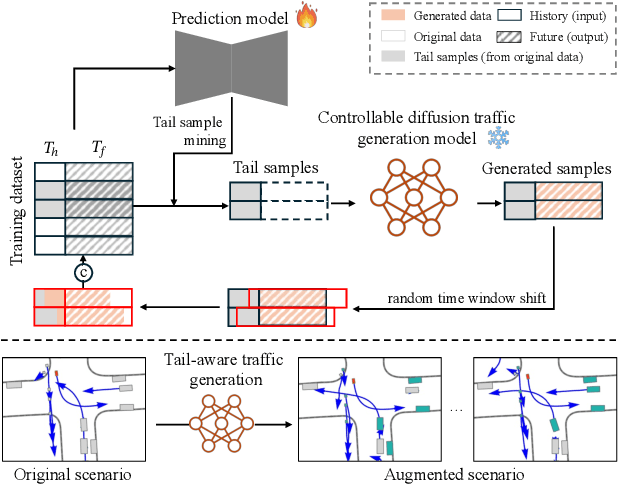

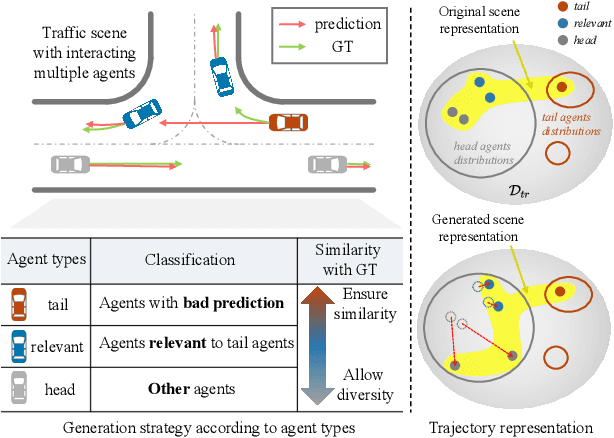
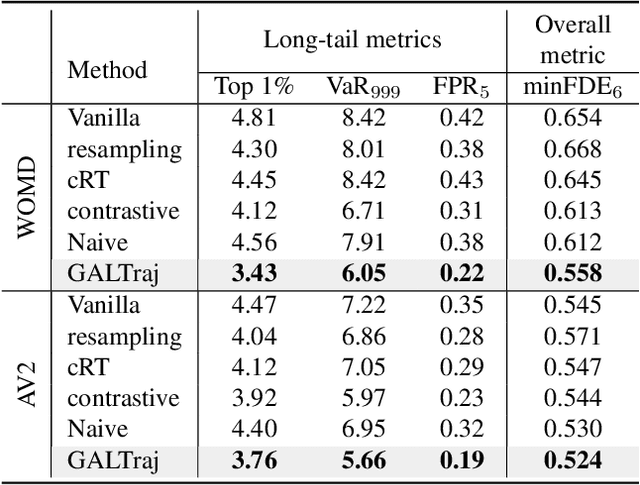
Abstract:While data-driven trajectory prediction has enhanced the reliability of autonomous driving systems, it still struggles with rarely observed long-tail scenarios. Prior works addressed this by modifying model architectures, such as using hypernetworks. In contrast, we propose refining the training process to unlock each model's potential without altering its structure. We introduce Generative Active Learning for Trajectory prediction (GALTraj), the first method to successfully deploy generative active learning into trajectory prediction. It actively identifies rare tail samples where the model fails and augments these samples with a controllable diffusion model during training. In our framework, generating scenarios that are diverse, realistic, and preserve tail-case characteristics is paramount. Accordingly, we design a tail-aware generation method that applies tailored diffusion guidance to generate trajectories that both capture rare behaviors and respect traffic rules. Unlike prior simulation methods focused solely on scenario diversity, GALTraj is the first to show how simulator-driven augmentation benefits long-tail learning in trajectory prediction. Experiments on multiple trajectory datasets (WOMD, Argoverse2) with popular backbones (QCNet, MTR) confirm that our method significantly boosts performance on tail samples and also enhances accuracy on head samples.
From Sharp to Blur: Unsupervised Domain Adaptation for 2D Human Pose Estimation Under Extreme Motion Blur Using Event Cameras
Jul 30, 2025Abstract:Human pose estimation is critical for applications such as rehabilitation, sports analytics, and AR/VR systems. However, rapid motion and low-light conditions often introduce motion blur, significantly degrading pose estimation due to the domain gap between sharp and blurred images. Most datasets assume stable conditions, making models trained on sharp images struggle in blurred environments. To address this, we introduce a novel domain adaptation approach that leverages event cameras, which capture high temporal resolution motion data and are inherently robust to motion blur. Using event-based augmentation, we generate motion-aware blurred images, effectively bridging the domain gap between sharp and blurred domains without requiring paired annotations. Additionally, we develop a student-teacher framework that iteratively refines pseudo-labels, leveraging mutual uncertainty masking to eliminate incorrect labels and enable more effective learning. Experimental results demonstrate that our approach outperforms conventional domain-adaptive human pose estimation methods, achieving robust pose estimation under motion blur without requiring annotations in the target domain. Our findings highlight the potential of event cameras as a scalable and effective solution for domain adaptation in real-world motion blur environments. Our project codes are available at https://github.com/kmax2001/EvSharp2Blur.
Non-differentiable Reward Optimization for Diffusion-based Autonomous Motion Planning
Jul 17, 2025
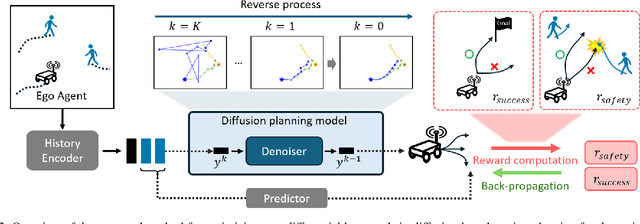
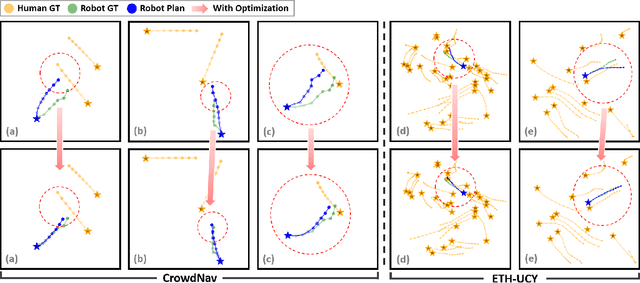

Abstract:Safe and effective motion planning is crucial for autonomous robots. Diffusion models excel at capturing complex agent interactions, a fundamental aspect of decision-making in dynamic environments. Recent studies have successfully applied diffusion models to motion planning, demonstrating their competence in handling complex scenarios and accurately predicting multi-modal future trajectories. Despite their effectiveness, diffusion models have limitations in training objectives, as they approximate data distributions rather than explicitly capturing the underlying decision-making dynamics. However, the crux of motion planning lies in non-differentiable downstream objectives, such as safety (collision avoidance) and effectiveness (goal-reaching), which conventional learning algorithms cannot directly optimize. In this paper, we propose a reinforcement learning-based training scheme for diffusion motion planning models, enabling them to effectively learn non-differentiable objectives that explicitly measure safety and effectiveness. Specifically, we introduce a reward-weighted dynamic thresholding algorithm to shape a dense reward signal, facilitating more effective training and outperforming models trained with differentiable objectives. State-of-the-art performance on pedestrian datasets (CrowdNav, ETH-UCY) compared to various baselines demonstrates the versatility of our approach for safe and effective motion planning.
Resolving Token-Space Gradient Conflicts: Token Space Manipulation for Transformer-Based Multi-Task Learning
Jul 10, 2025Abstract:Multi-Task Learning (MTL) enables multiple tasks to be learned within a shared network, but differences in objectives across tasks can cause negative transfer, where the learning of one task degrades another task's performance. While pre-trained transformers significantly improve MTL performance, their fixed network capacity and rigid structure limit adaptability. Previous dynamic network architectures attempt to address this but are inefficient as they directly convert shared parameters into task-specific ones. We propose Dynamic Token Modulation and Expansion (DTME-MTL), a framework applicable to any transformer-based MTL architecture. DTME-MTL enhances adaptability and reduces overfitting by identifying gradient conflicts in token space and applying adaptive solutions based on conflict type. Unlike prior methods that mitigate negative transfer by duplicating network parameters, DTME-MTL operates entirely in token space, enabling efficient adaptation without excessive parameter growth. Extensive experiments demonstrate that DTME-MTL consistently improves multi-task performance with minimal computational overhead, offering a scalable and effective solution for enhancing transformer-based MTL models.
Synchronizing Task Behavior: Aligning Multiple Tasks during Test-Time Training
Jul 10, 2025Abstract:Generalizing neural networks to unseen target domains is a significant challenge in real-world deployments. Test-time training (TTT) addresses this by using an auxiliary self-supervised task to reduce the domain gap caused by distribution shifts between the source and target. However, we find that when models are required to perform multiple tasks under domain shifts, conventional TTT methods suffer from unsynchronized task behavior, where the adaptation steps needed for optimal performance in one task may not align with the requirements of other tasks. To address this, we propose a novel TTT approach called Synchronizing Tasks for Test-time Training (S4T), which enables the concurrent handling of multiple tasks. The core idea behind S4T is that predicting task relations across domain shifts is key to synchronizing tasks during test time. To validate our approach, we apply S4T to conventional multi-task benchmarks, integrating it with traditional TTT protocols. Our empirical results show that S4T outperforms state-of-the-art TTT methods across various benchmarks.
Multi-modal Knowledge Distillation-based Human Trajectory Forecasting
Mar 28, 2025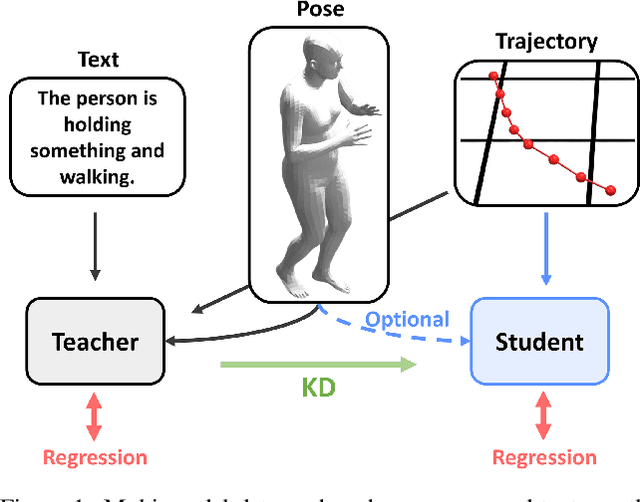

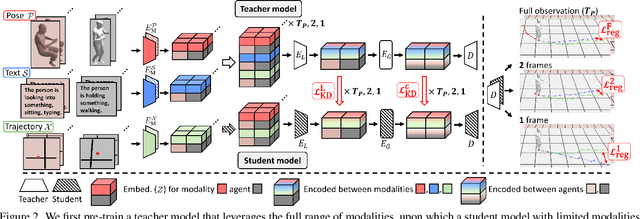

Abstract:Pedestrian trajectory forecasting is crucial in various applications such as autonomous driving and mobile robot navigation. In such applications, camera-based perception enables the extraction of additional modalities (human pose, text) to enhance prediction accuracy. Indeed, we find that textual descriptions play a crucial role in integrating additional modalities into a unified understanding. However, online extraction of text requires the use of VLM, which may not be feasible for resource-constrained systems. To address this challenge, we propose a multi-modal knowledge distillation framework: a student model with limited modality is distilled from a teacher model trained with full range of modalities. The comprehensive knowledge of a teacher model trained with trajectory, human pose, and text is distilled into a student model using only trajectory or human pose as a sole supplement. In doing so, we separately distill the core locomotion insights from intra-agent multi-modality and inter-agent interaction. Our generalizable framework is validated with two state-of-the-art models across three datasets on both ego-view (JRDB, SIT) and BEV-view (ETH/UCY) setups, utilizing both annotated and VLM-generated text captions. Distilled student models show consistent improvement in all prediction metrics for both full and instantaneous observations, improving up to ~13%. The code is available at https://github.com/Jaewoo97/KDTF.
Any6D: Model-free 6D Pose Estimation of Novel Objects
Mar 25, 2025Abstract:We introduce Any6D, a model-free framework for 6D object pose estimation that requires only a single RGB-D anchor image to estimate both the 6D pose and size of unknown objects in novel scenes. Unlike existing methods that rely on textured 3D models or multiple viewpoints, Any6D leverages a joint object alignment process to enhance 2D-3D alignment and metric scale estimation for improved pose accuracy. Our approach integrates a render-and-compare strategy to generate and refine pose hypotheses, enabling robust performance in scenarios with occlusions, non-overlapping views, diverse lighting conditions, and large cross-environment variations. We evaluate our method on five challenging datasets: REAL275, Toyota-Light, HO3D, YCBINEOAT, and LM-O, demonstrating its effectiveness in significantly outperforming state-of-the-art methods for novel object pose estimation. Project page: https://taeyeop.com/any6d
Ev-3DOD: Pushing the Temporal Boundaries of 3D Object Detection with Event Cameras
Feb 26, 2025Abstract:Detecting 3D objects in point clouds plays a crucial role in autonomous driving systems. Recently, advanced multi-modal methods incorporating camera information have achieved notable performance. For a safe and effective autonomous driving system, algorithms that excel not only in accuracy but also in speed and low latency are essential. However, existing algorithms fail to meet these requirements due to the latency and bandwidth limitations of fixed frame rate sensors, e.g., LiDAR and camera. To address this limitation, we introduce asynchronous event cameras into 3D object detection for the first time. We leverage their high temporal resolution and low bandwidth to enable high-speed 3D object detection. Our method enables detection even during inter-frame intervals when synchronized data is unavailable, by retrieving previous 3D information through the event camera. Furthermore, we introduce the first event-based 3D object detection dataset, DSEC-3DOD, which includes ground-truth 3D bounding boxes at 100 FPS, establishing the first benchmark for event-based 3D detectors. The code and dataset are available at https://github.com/mickeykang16/Ev3DOD.
Selective Task Group Updates for Multi-Task Optimization
Feb 17, 2025


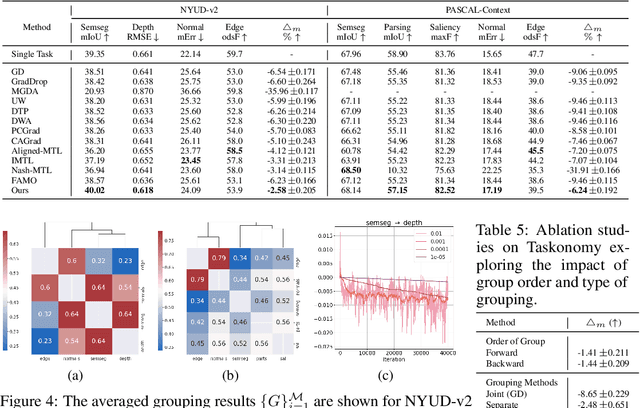
Abstract:Multi-task learning enables the acquisition of task-generic knowledge by training multiple tasks within a unified architecture. However, training all tasks together in a single architecture can lead to performance degradation, known as negative transfer, which is a main concern in multi-task learning. Previous works have addressed this issue by optimizing the multi-task network through gradient manipulation or weighted loss adjustments. However, their optimization strategy focuses on addressing task imbalance in shared parameters, neglecting the learning of task-specific parameters. As a result, they show limitations in mitigating negative transfer, since the learning of shared space and task-specific information influences each other during optimization. To address this, we propose a different approach to enhance multi-task performance by selectively grouping tasks and updating them for each batch during optimization. We introduce an algorithm that adaptively determines how to effectively group tasks and update them during the learning process. To track inter-task relations and optimize multi-task networks simultaneously, we propose proximal inter-task affinity, which can be measured during the optimization process. We provide a theoretical analysis on how dividing tasks into multiple groups and updating them sequentially significantly affects multi-task performance by enhancing the learning of task-specific parameters. Our methods substantially outperform previous multi-task optimization approaches and are scalable to different architectures and various numbers of tasks.
 Add to Chrome
Add to Chrome Add to Firefox
Add to Firefox Add to Edge
Add to Edge